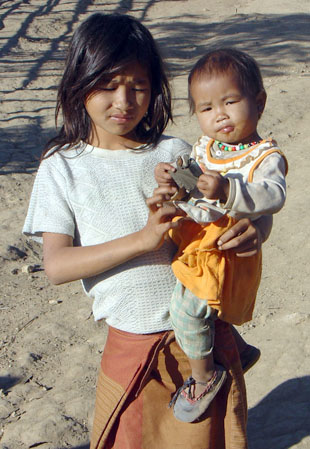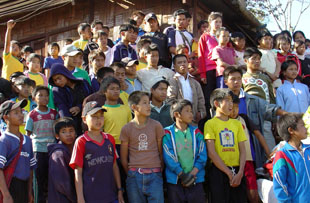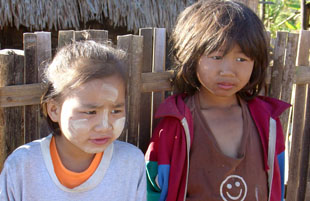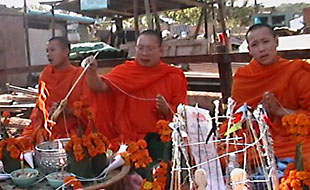Love each other.
Unite and work for freedom, peace, and justice.
Forgive and don’t hate each other.
Pray with faith.
Act with courage.
Never surrender.
—The motto of the Free Burma Rangers
“If I get discouraged, I can go home, but the Karen tribe cannot.”
These were the words of one of the many brave volunteers who make up the Free Burma Rangers (FBR) a humanitarian service organization which works closely with the many tribal defense forces, resisting the repression of the Burmese government. FBR’s stated mission is to bring “help, hope and love to people in the war zones of Burma.”
The group was founded in the wake of a Burmese Army offensive against ethnic minority peoples in 1997, which left countless dead, and over 100,000 homeless. According to statistics gathered by FBR, at the present time, more than 2,000,000 Burmese have been displaced.
The recent protests in Yangon have brought the plight of the Burmese people to the attention of the world. But for the tribal people, the war has been going on for nearly fifty years.
If you haven’t heard of this war, don’t be surprised, the Burmese junta, lead by General Than Shwe, has kept the country almost completely sealed. The internet, cell phones, and news media are under the complete control of the government. Email is censored. There is no foreign television. In the best of times, the only legal entry point for the country was Yangon, the former capitol, where visas were required. Tourists were closely watched and generally mistrusted. Journalists were strictly prohibited from entry into the country. With the possible exception of North Korea, no country in Asia has been kept as much in the dark as Burma.
The Free Burma Rangers is one of too few volunteer organizations, mostly comprised of westerners, working in cooperation with tribal armies, who enter Burma and document cases of human rights violations. Most large NGOs and international aid organizations have rules which prevent them from either breaking international law or helping armed groups. The UN, for example, can only send aid missions with the permission of the local government. Since the Burmese government is the enemy in this conflict, they would never give permission for the UN or anyone else to send aid missions to the war-torn tribal areas. The only access to the tribal people who need help is gained by crossing the border illegally, which large NGOs won’t do because they are prohibited by charter from breaking the law. The other issue which prevents most smaller NGOs from giving aid to the tribal groups is that many of them have rules preventing them from helping armed groups. But if the tribal groups were to lay down their arms, the SPDC would roll right over them. There would be no tribal people to help.

That leaves only the Free Burma Rangers and a few small NGOs to help the tribal people in the war zone.
Perhaps people should take this into consideration before making donations to larger organizations.
An FBR volunteer agreed to meet under the promise of complete anonymity. The Burmese junta is known to collect news clippings from around the world, using photos and names printed in foreign press to locate and punish dissidents within their own borders. If a ranger is detected, not only is his or her life endangered, but also the lives of any villagers who failed to turn him in to the authorities.
“The courage of the tribal people is inspiring,” said the volunteer.
FBR is open to cooperation with any of Burma’s ethnic minorities, but the majority of the people FBR works with are from the Karen. “They are the most unified, with the best political and military organization, and the best infrastructure.”
One possible reason that volunteers and intelligence gatherers have given why they find it easier to work with the Karen tribe is because they had a much closer relationship with the British, during the colonial times. As a result, a large percentage of Karen are Christian and speak English well.
The Shan, the other largest group, Shan State Army (SSA), had a history of funding their war with the sale of drugs. Today, they are out of the drug business, but suffer from the long memory of the very few organizations who are willing to help the tribal people. Over the last few years, FBR has been increasing their work with the SSA but the Shan are still desperately in need of international friends and supporters.
FBR operations include sending relief teams, with medical and food supplies to the afflicted areas.
“The teams provide medical relief and whatever we can give them to bring in plastic, cash for food, donated clothing, general supplies or other items which they can’t buy there.”
While on site, the teams document human rights abuses, and return. The data is then made available to the foreign pres, the UN, and international governmental and non-governmental organizations. Often, the FBR reports are the only news that manages to escape the vice like grip of the Burmese junta.

In addition to giving immediate relief, the FBR run educational programs, where they train tribal people to run relief and intelligence teams.
“We work through local leadership” explained the volunteer. “The tribal organization, will pick people and send them to our course. We just train them and send them back.”
The local leaders take command of the newly trained groups, and deploy them in the field. The volunteer felt this system worked out well, making the FBR into a cooperative, rather than competitive authority.
The training has long range impact on the tribal people themselves. “It helps build civil society because it gives the existing leadership a core of young, skilled, qualified future leaders. After the course, they have had training in communication equipment, modern technology, and basic medical. They learn to do interviews and to document human rights abuses.”
For the tribal people, dealing with war and battling repression has been a central theme in their lives for generations.
“The Karen state bears the brunt of the government attacks. The Shan state also gets hit a lot. Other areas are ceasefire areas, so it is a little more clandestine.”
In addition to battling the government troupes, the tribal people are also faced by proxy armies, groups of tribal people who defected to the government side.
“Any time you have a hot zone like that, it is to be expected that people get burned out. Joining the government side seems like the easy way out.”
The monk lead protests in Yangon haven’t changed anything for the tribal people.
“Most of the tribal people are either Christian or Animist, but everyone we know in the tribal areas supports the protests in Yangon. They held a rally and put out a statement saying that they supported the Burmese in Yangon who were defying the government.”
Unfortunately, beyond sending prayers and messages of solidarity, the tribes have no way of aligning with the Yangon protestors.
“The military forces of the ethnic groups are just too small. They are defense forces, with a common goal of defending their territory.”
The tribal people are severely outnumbered, as the majority of the country’s population is Burmese. To date, there doesn’t appear to be an armed Burmese resistance group. After the 1988 student uprisings, there were small bands of ethnic Burmese from the cities, who joined up to fight along side the tribal armies.
“They were very few, not well organized, and were never fully trusted by the tribal people.”
In the wake of the recent protests, it was hoped that the government’s attention would be drawn toward Yangon and away from the tribal areas.
“We thought maybe the government would start pulling troops from the border areas, but it hasn’t happened. Now is the beginning of the dry season, so troop movement will increase.” A major offensive, begun in 2006 is still ongoing. “In 2006, they pushed harder than before. It was the worst fighting in ten years. Since that began, 30,000 people have been displaced. Over 300 – 400 were killed.”
Of those displaced in the most recent push an estimated 4,000 – 7,000 have escaped to refugee camps outside of the country. Life in a refugee camp is more chaos, as if the poor victims have stepped out of the frying pan and into the fire.
“The camps just grew up overnight, with thousands of people living shoulder to shoulder. Only a little bit of aid can get in. Half the people registered in the camp don’t live there. And at least half of those living there are not registered.”

Traditionally, tribal people do not leave their homelands. The animist beliefs will keep them there because they need to stay close to the spirits of their ancestors. Culturally, they feel more at home, surrounded by their extended family, and speaking their own language.
“Normally, the only reason they would leave their home is if they are going to starve. To see so many of them running away tells you that it must be something terrible.”
The mass exodus of tribal people has caused a break in the agricultural cycle. With fewer people left in the villages, fields go unplanted, and the remaining villagers could go hungry.
The volunteer believed that this was all part of the junta’s plan, for the slow annihilation of the tribal people.
“The Burmese government doesn’t attack headlong. One strategy they implemented was to build new roads, cutting the Karen state into fours.”
The roads were mined and army encampments were built along these new thoroughfares, which bisected the walking paths local people used to trade with other villages.
“Now it is easy to control. Villagers have to travel to get basics like salt, which they can’t make themselves. If they come up on a patrolling Burmese army troop, they can be shot at, taxed, or impressed for forced labor.”
The new controls have disrupted trade and communication between villages, further isolating the people and making them even more vulnerable to attack.
“It’s not necessarily always a hot war. Instead, it is a slow strangulation, a gradual decrease of the people’s normal breathing. And that has increased in the last two years.”
The Burmese government is one of the most paranoid in the world. The army is estimated to have more than 400,000 soldiers, with defense expenditure equaling 50% of the national budget.
“The country has no external enemies at all, but they spend half their income on defense. It is an army created to attack its own people.”

Perhaps the most peculiar action taken by the junta was secretly relocating the country’s capital, under cover of darkness, to a secluded area, known as Pyinmana.
A recent refugee from Yangon said that government workers were so underpaid that they were completely dependent on their side jobs, which they lost in the move. They would have quit the government, but the junta ordered that it was illegal to resign a government post. As a result, families have been torn apart as the husband or wife who worked for the government was forced to relocate, but the spouse and children remained behind in Yangon.
“It seems like the time is right for the people to protest. It is probably not a coincidence that the people are taking to the streets.”
As incompetent as the Burmese government seems to be at matters of human rights, quality of life, and economic policy, the one thing they are good at is maintaining control.
“They have managed to stay in power for fifty years, by creating enough fear and disunity in the country that no one could stand up to them..”
“Last week, they burned a village.”
The Karen army provided early warning to the people. So the majority of the villagers were able to run away.
“Usually, the army comes in and loots, burns, or mines the village and moves on. It depends a lot on the individual local commander. He has a lot of autonomy and not a lot of accountability. The Burmese army is also very corrupt. On a given day, a troop could march into a village, burn it down, and the people run away. The next day, the people come back, rebuild and re-establish trade with the army, because the soldiers live there too.”
At other times, the soldiers kill everyone in the village or take them away, as slave laborers.
“There haven’t been many mass killings in a long time. Most recent shootings have been people getting hit, while they were running away. In the Spring of 2006, the army forced 800 people to work as porters.”
In the case of slave labor, the troop commander will come into the village and tell the headman how many workers he must supply. If he refuses, he could be tortured or killed.
“When they take away that many workers, everything going on in the village stops.”
Villagers can’t plant, and that adds to their suffering.
“The soldiers don’t necessarily feed the forced laborers, and they don’t treat them well. A lot of the statistics we have on people killed are based on the porters. They are required to carry heavy burdens, and they aren’t fed. If they don’t move fast enough or they collapse, they are beaten or killed.”
The abuses seem to be endemic to the system.
“It is what you would expect when you have a power disparity and no accountability.”
The soldiers, of course, come from the lowest ranks of society.
“They are not treated well on their side either.”
There are widespread reports of soldiers being abused by their superiors.
Recent reports say that the army is taking younger and younger recruits. Boys, as young as 12 years old, are allegedly gathered up at the markets and forced to serve in the army. There is a lot of speculation on why this is happening. One reason people believe is that no Burmese would go willingly to the army if he believes he would be forced to kill a monk.
The volunteer described Burma as a problem with no end.
“On the one side, we are giving band-aid solutions. We can send in a medical team to treat malnutrition or malaria, and they can help. But after they leave, the people will be in the same position again.”
As dismal as the situation is, there is still hope.
“The long term benefit of our work is that it provides encouragement. And, who can say how valuable that is. It lets the people know that they haven’t been forgotten by the outside world. It gives them hope that maybe an end will come. If you were sitting there, in the jungle, fighting, thinking no one knows anything about your struggle, it would be easy to lose heart. But if someone comes from the outside and says we know you are here we know what is happening, it keeps you going.”
“The other benefit is that our work is creating a core group of villagers who have training in modern technology. It gives them the ability to help their people. Right now if you are a young kid in the village, seeing this horrible stuff happen, and you think what can I do to help my people? The only option is joining the army. Now, our training gives them practical skills so if the government does change, there will be leaders waiting to take up the reigns.”
“If I get discouraged I can go home, but the Karen cannot. I could go on with my life, but they have been doing this for years and haven’t quit. They are poor materially, but rich in spirit. In some places we see displaced people set up a camp, and a week later, the school is open.”
In spite of battling against overwhelming odds, and in the face of an international community who has yet to give them any concrete help, the people of Burma, both tribal and Burmese, aided by a few brave volunteers, continue their struggle for democracy. Let us all be inspired by their courage.
Read Ethical Traveler's Reprint Policy.
